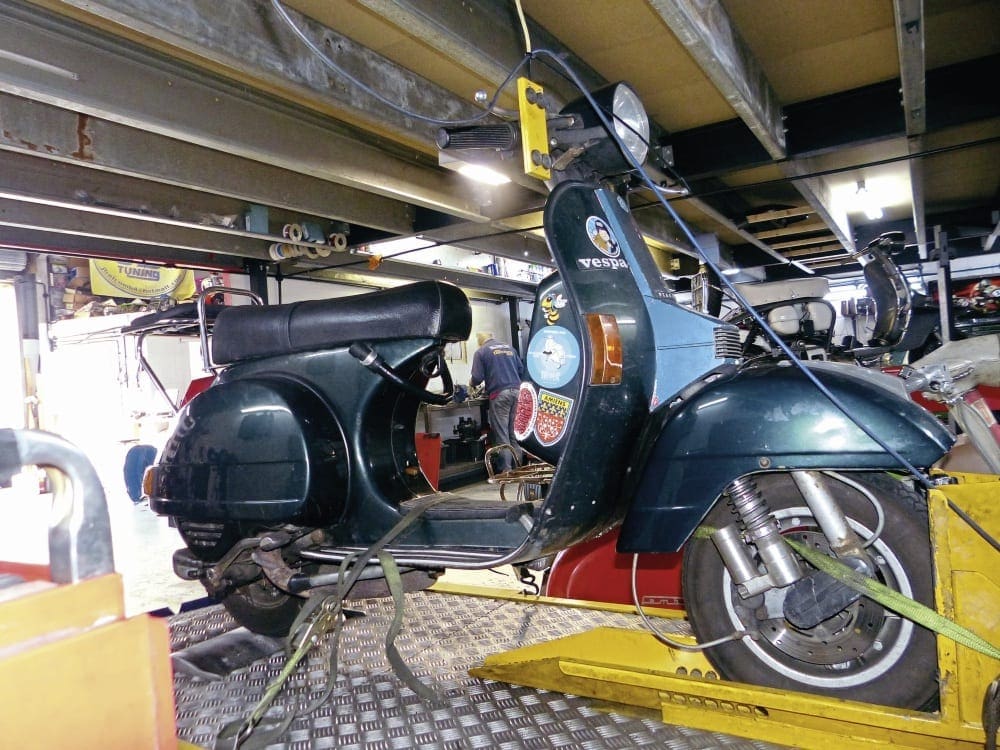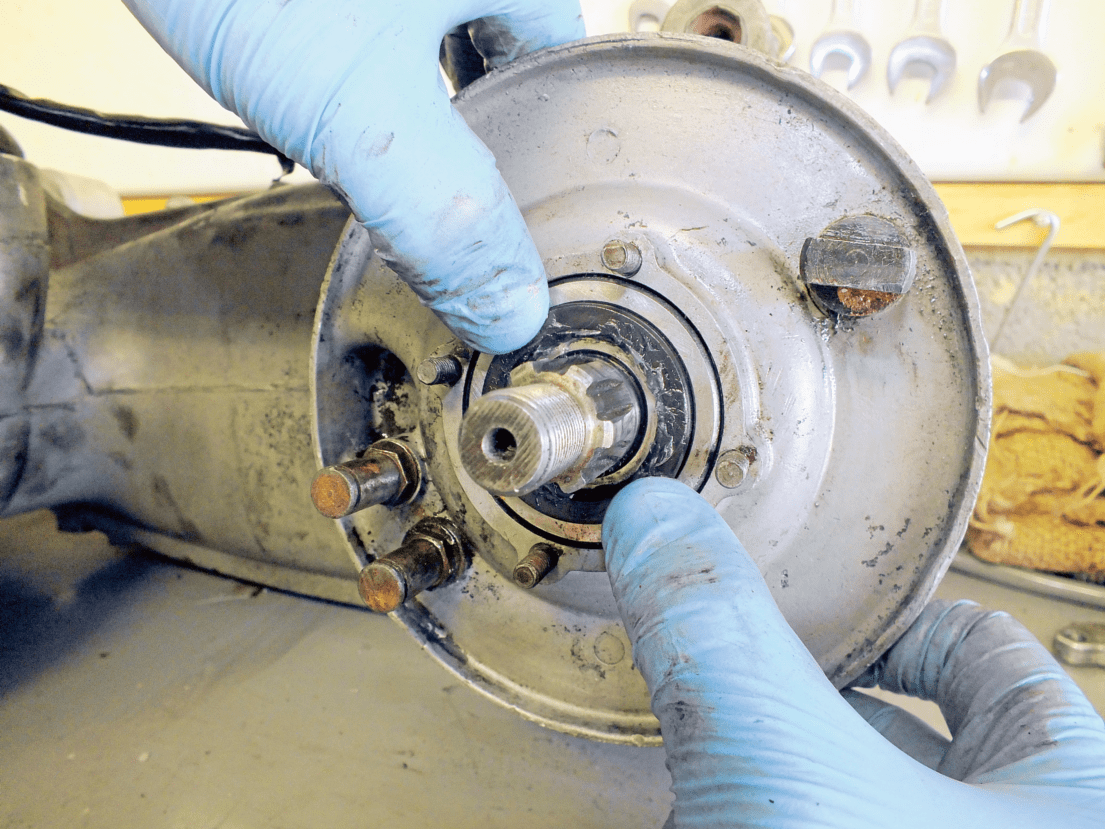It seems today that standard looking expansion pipe exhaust systems are more in vogue than ever among the classic scooter fraternity, which is why we’re back testing such items on the large frame Vespa PX200
Why? A standard looking ‘Big Box’ retains the original look of your scooter and emits a similar tone too. From a practical point of view they all allow you to carry a spare wheel under the left side panel and indeed change the rear wheel without obstruction, as well as easily adjust the clutch cable should you need to, tasks made difficult by fitting aftermarket sporty looking pipes which may also have clearance issues too. Then of course there’s the potential to gain a little performance in the process, and who doesn’t want to go a little bit faster if there’s an easy way to gain a few mph? After all, Piaggio’s exhaust design hasn’t really changed much over the years, so it makes sense if changing your pipe to look at the modern options. Speaking of which, the last time I tried to buy an original genuine Piaggio P200 exhaust I tried three that didn’t fit before giving up. Not impressive for the best part of £80…
The testing: We used my old faithful, mechanically standard PX200E which began the day with all the factory-set jetting (118 main jet) in the original 24mm carburettor. As we progress through the pipes, and the dyno readings suggested it, we altered the jetting until each exhaust gave a good reading – albeit often slightly rich which is how I tend to run my bikes anyway. In each case we down-jetted the main, as far as 110 in one case, often increasing the pilot in return and sometimes altering the air mixture too. Remember though that each scooter will differ with their jetting requirements when you come to doing yours. You should also remember that most of these exhausts are available in 125/150cc versions too for other Vespa and LML scooters, albeit with different downpipes, and while the result won’t transpose exactly, our review of the 200 version should give a good idea of what to expect from their smaller siblings (please note that in some photos the securing springs may not have been fitted correctly to save time, and the main exhaust bolt might be absent depending on when in the fitting process the photo was taken).
The graphs: Each graph shows the power and torque of the relevant exhaust (light blue and dark blue lines) in a third gear run, with the standard Piaggio PX200 exhaust graph line showing its max power (red) and torque (dark red) figures of 9.93bhp and 11.6lb-ft respectively as the base line.
THE VESPA BIG BOX EXHAUST TEST
As well as these figures, the revs are also of interest. Vespa PX 200s have a reputation for pulling well low down (inspiring the LML factory in India to develop their 150 with similar torque), and holding on to the power better at top end where the likes of the revvy T5 fail when up against anything too challenging. With the power spread wider beyond the range of a standard PX200, you will find either better pull away, or with the power lasting longer with more revs at top end then you not only have a faster Vespa but one which is happier at carrying loads, challenging hills, confronting headwinds, or maybe taking on all three.
SITO PLUS: RRP: £89.30 200cc & 125/150cc versions: Yes Fit: Clamp around barrel stub and bolt through engine swingarm. Availability: UK scooter shops via VE UK Contact: www.ve-uk.com
Sito has been offering Vespa riders this option, based on the standard T5 exhaust, for many years now, and until recently it was the only option regarding fit, price and a little performance boost too. The sound is a bit louder and more tinny than standard. However in recent years the Sito Plus has come under attack on all sides and without any obvious development from Sito, the Plus finds itself somewhat lacking. While power is slightly up on a standard pipe, torque isn’t and it struggles to rev much further than Piaggio’s exhaust too. Combine this with a main engine-bolt hole that doesn’t line up (we tried two) and it doesn’t bode well.
PINASCO TOURING: RRP: £122.47 200cc & 125/150cc versions: Yes Fit: Clamp around barrel stub with spring mounts too, and bolt through engine swingarm. Availability: UK scooter shops via VE UK Contact: www.ve-uk.com

A strange cylindrical shape for this pipe, presumably inspired by the Rally 180 exhaust of the late 1960s. The build quality looks good, it was easy to fit and like most of the others required the main jet to be downsized. Of all the exhausts on the test here it was either the loudest, or it had the most unusual tone compared to the rest. It’s not the cheapest here, nor the best performing, especially regarding peak torque, but it revs on over a standard and Sito pipe and at 6500rpm produces 8.6bhp and 10.8lb-ft of torque.
SIP ROAD 2: RRP: £99.97 200cc & 125/150cc versions: Yes Fit: Clamp around barrel stub, spring to casing and bolt through engine swingarm. Availability: Direct from SIP in Germany or UK scootershops via VE UK Contact: www.sip-scootershop.com
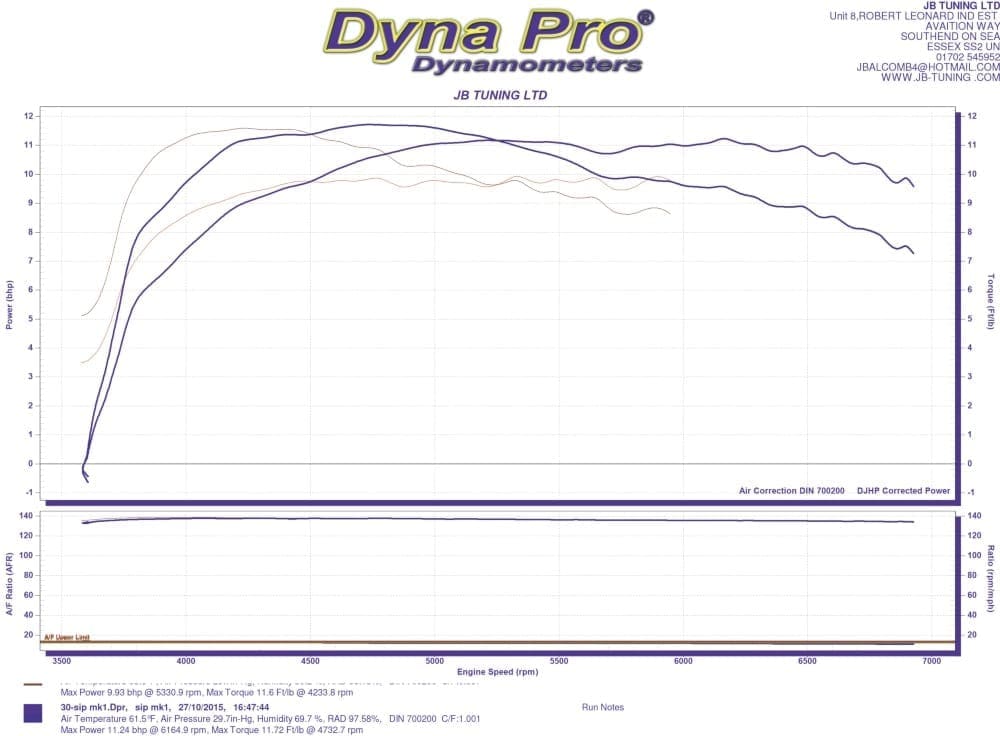
The SIP Road 2 is the exhaust I’ve been using on my scooter for a couple of years now and I have to say I’m very pleased with it. As can be seen from the photos, it’s been used all year round and despite a Zircotec coating, still looks abused (this was done separately from SIP so is not a representation of their own finish after two years). It fitted well, the tone only a little more than a standard exhaust and at 6500rpm it still has 11bhp and 9lb-ft or torque, which on the road means seeing 70mph on the speedometer is not uncommon. I do like it and indeed refitted it for the ride home.
SIP ROAD XL: RRP: £143.12 Fit: Clamp around barrel stub, spring to casing and bolt through engine swingarm. 200cc & 125/150cc versions: Yes Availability: Direct from SIP in Germany or UK scootershops via VE UK Contact: www.sip-scootershop.com
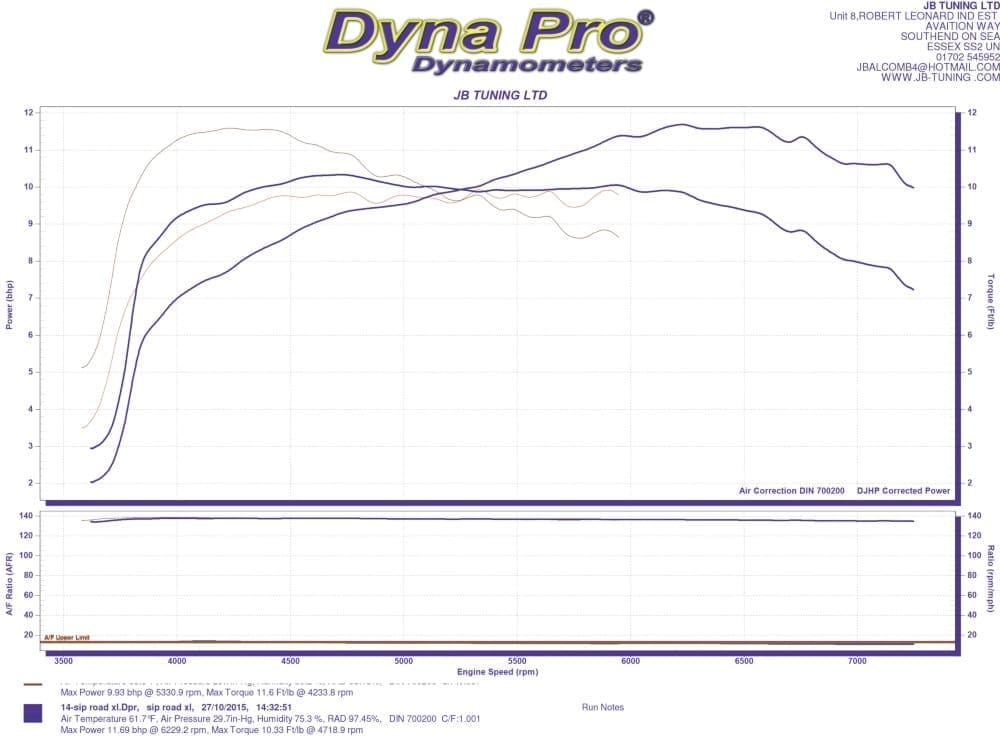
As you might expect, the XL has the same production quality as the Road 2 and is just as easy to fit. Where it differs is with the multi-sectioned downpipe and the fatter box which is apparently improved with regards to ground clearance since our last test of the prototype version. Incidentally, it also clears the stand spring. SIP has aimed the XL at tuned engines, which could explain why the torque is not the best. However it did achieve the second best power on the day and at 6500rpm boasts an impressive 11.69hp with about 9.3lb-ft of torque.
TSR VORTEX: RRP: €139/£99.99 200cc & 125/150cc versions: Yes Fit: O-ring inside barrel stub, with spring mounts too, and bolt through engine swingarm. Availability: Direct from LTH in Germany or TSR in the UK Contact: www.lambretta-teile.de / www.thescooterrepublic.co.uk (01633 549282)

There is no barrel stub clamp with this exhaust, instead an O-ring fitted inside the downpipe makes a tight fit on the stub (a little dab of grease helped it on) with two springs (one to a cowl mount, the other needing a hole in a barrel or head fin) securing it on the barrel, together with the main engine bolt of course. Note that once removed, the O-ring needed replacing so you must consider having a spare to hand. This exhaust is the result of cooperation between LTH in Germany who designed the pipe, and The Scooter Republic (TSR) in Wales who had it manufactured in Vietnam. It has a longer downpipe that the rest, cleverly tucked back on itself, which suggested it would be good from the start, and once jetted correctly it offered the best torque of the lot. However it didn’t want to rev as freely as many of the others.
PIPE DESIGN S-BOX: RRP: €TBC 200cc & 125/150cc versions: Fit: Barrel stub clamp and bolt through engine swingarm. Availability: Direct from Pipe Design Contact: www.pipedesign.de

The remit here appears to have been to literally take one standard Piaggio PX200 exhaust and make it better. As a result we appear to have the original barrel mount down pipe and fitting, and the external box (complete with Piaggio part number and DGM approval stamp), yet Pipe Design have worked their magic by creating a sectioned downpipe into the box and presumably altered things inside too. And it fits like a glove. We tried a 110 and 112 main carb jet as well as upjetting the pilot to gain the best results here. Performance wise it produces less peak torque than the standard exhaust but holds what it gives for a quite a while, offering 9lb-ft at 6500rpm while still producing over 11bhp there. It revs on nicely too, beyond 7000rpm. We’re told Pipe Design makes Vespa Big Box pipes to order so would produce a different one for a kitted engine depending on the spec.
BGM PRO – Big Box Sport: RRP: €199.99 Fit: Barrel clamp with spring mounts too, and bolt through engine swingarm. 200cc & 125/150cc versions: Yes Availability: Scooter Center Koln Contact: ww.scootercenter.com

The BGM exhausts have probably the most secure looking and feeling downpipe clamps of them all, an area that can be weak as Vespa owners know. The Sport version of the Big Box exhaust also has an incredibly fat downpipe, which fouled on our stand spring in its normal position. Apart from that the fit was good. And the sound was subtle too. We down jetted the carb’s main jet to a 112 and increased the pilot for this and while the torque figure is down a little on standard, it’s in nice and early and goes the distance, showing over 9lb-ft at 6500rpm at which point it still has more than 11.5bhp. As the name suggests, this will probably fair very well on a kitted engine.
BGM PRO – Big Box Touring: RRP: €158.99 200cc & 125/150cc versions: Yes Fit: Barrel clamp with spring mounts too, and bolt through engine swingarm. Availability: Scooter Center Koln Contact: ww.scootercenter.com
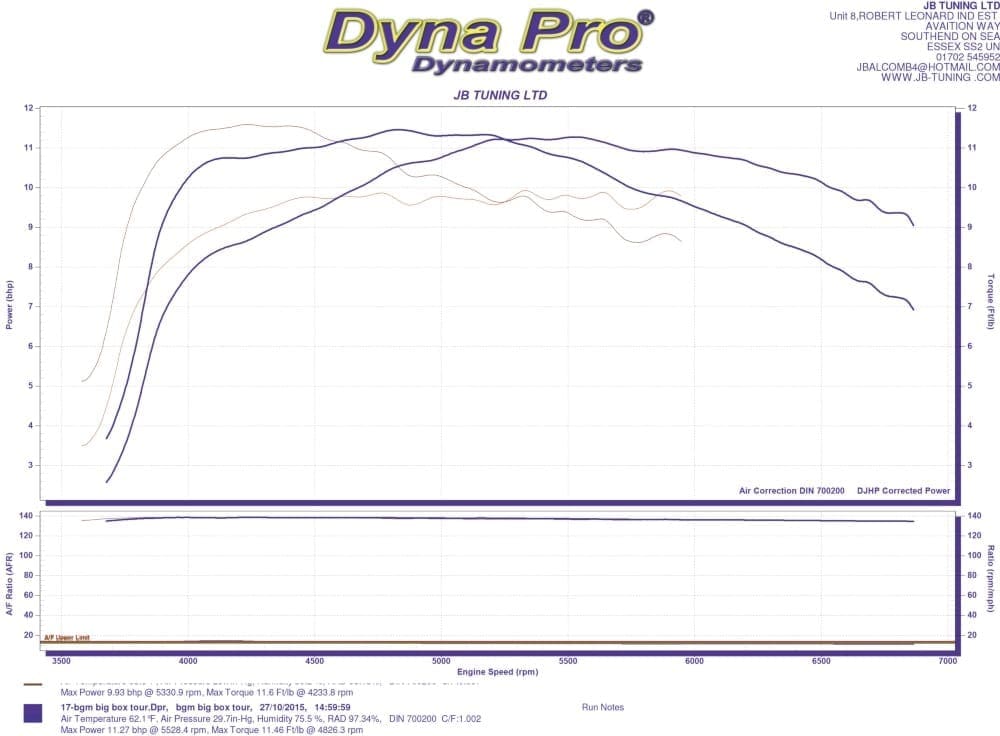
Like the Sport this is an easy pipe to fit, the clamp meaning it’s tight but in a secure way rather than negative, with springs supplementing the clamp. The build quality is also good, as expected. Down-jetting for this was less than with the Sport pipe, but once sorted the graph was good, torque coming in nice and early. It doesn’t hold on to it for as long as some of the others mind you, but as BGM says this exhaust was “developed for a solid push beginning at low rpm”. The firm also claims that this exhaust is suited to sidecar riders as due to the “high torque available it is no longer necessary to shorten the gear reduction”.
Which pipe?
What has to be considered here is that certain exhausts in our test are likely to have been developed with slightly different goals in mind and indeed different riders will have different needs from them. What they do all offer is a viable alternative to a standard exhaust with varying degrees of improvements, if such things appeal. All the aftermarket exhausts here let the engine rev on much farther than standard, with the exception of the Sito Plus and to a lesser extent the LTH/TSR pipe, although both are better than standard – the latter much more so of course. At the cheap end, sadly the Sito Plus (£89.30) may well have had it’s day; the fit isn’t great, performance increase minimal, and for just a few quid more you can get the SIP Road 2 or LTH/TSR pipe, and at current exchange rates the BGM Touring isn’t a lot more, all of which offer more.
On the Sito, UK importer VE UK’s Rob Kerr told us: “We are relatively pleased with the results of the Sito Plus for the cheapest exhausts in the test, it’s gaining on both power and revs quite nicely over the standard exhaust, which is exactly what Sito was aiming for when they designed it, remember that it was never designed to be a full on sports exhaust, just a simple upgrade over standard.” VE also imports the Pinasco Touring, saying: “The Pinasco is pushing the revs further along, which is to be expected from a company focused on tuning and although not as torquey as the SIP road, it was probably developed to work best with a Pinasco cylinder, which with the different porting will give different results.”
Then we get to the BGM and SIP exhausts, both companies offering pipes that perform very well here with a version from each looking to be leading the charge for our kitted engine review in the future. From BGM the Sport appears to have the edge over the Touring, but it’s a tough decision to make. BGM says about the Touring: “An early performance delivery and the significant increase in torque make our Big Box’s Touring version an ideal companion for anyone who likes to travel as a couple or with a lot of luggage.”
From SIP I still rate the Road 2, for the standard PX200 and it’s cheaper than the XL as well. As SIP told us: “The Road XL is targeted to tuned up engines above 20hp and it is really working well then. For standard or light tuned engines we always recommend the Road 2.0.” At the end of the day, I refitted the Road 2 to my scooter for the ride home.
The Pipe Design is interesting and has the legs to rev, but is let down by its peak figures, although while Marco at PD tells us this pipe is for a standard engine, it looks like it would do well on a tuned motor as well. So while it is a close run contest, if you will, between the German designed exhausts
here, the LTH/TSR pipe has the torque that suggests if you want to go touring two-up on a standard scooter then this might be the one. It doesn’t rev as much as some others, which suggests it is in fact more of an improvement on a standard exhaust rather than a standard looking expansion pipe, if that makes sense. But then the standard Piaggio exhaust is pretty good for what it is anyway. LTH’s Marco Büttner said, “The test figures match the tendencies of our results on other engine types. We never did a test on a stock 200, the exhaust has been developed on a stock Malossi Sport 68.5 x 57mm. The aim was to design an exhaust for long distance riders, fed up of changing gears all the time so all decisions we did we focused on their needs or at least what we thought they are. The main decision was to opt for more torque at low revs rather than max power at higher revs, which is something you always have to decide in exhaust development.”
Next time
What this test has proved is that the market for Vespa big box exhausts has become very competitive of late with the result being that the choice of quality products for the customer is greater than before, which can only be a good thing. It doesn’t make our choice any easier, but does mean the manufacturers will be pulling out the stops to stay one step ahead of each other. As the manufacturers have told us, and graphs confirmed, some of these exhausts are better suited for tuned Vespa engines, and this is something we plan to do in the next few months, once the Malossi 210 is back on the road. In the meantime it’s been interesting to learn what some of these manufacturers will think the results of that test will be…
Andy
 This article first appeared in Dec 2015 edition of Scootering.
This article first appeared in Dec 2015 edition of Scootering.




